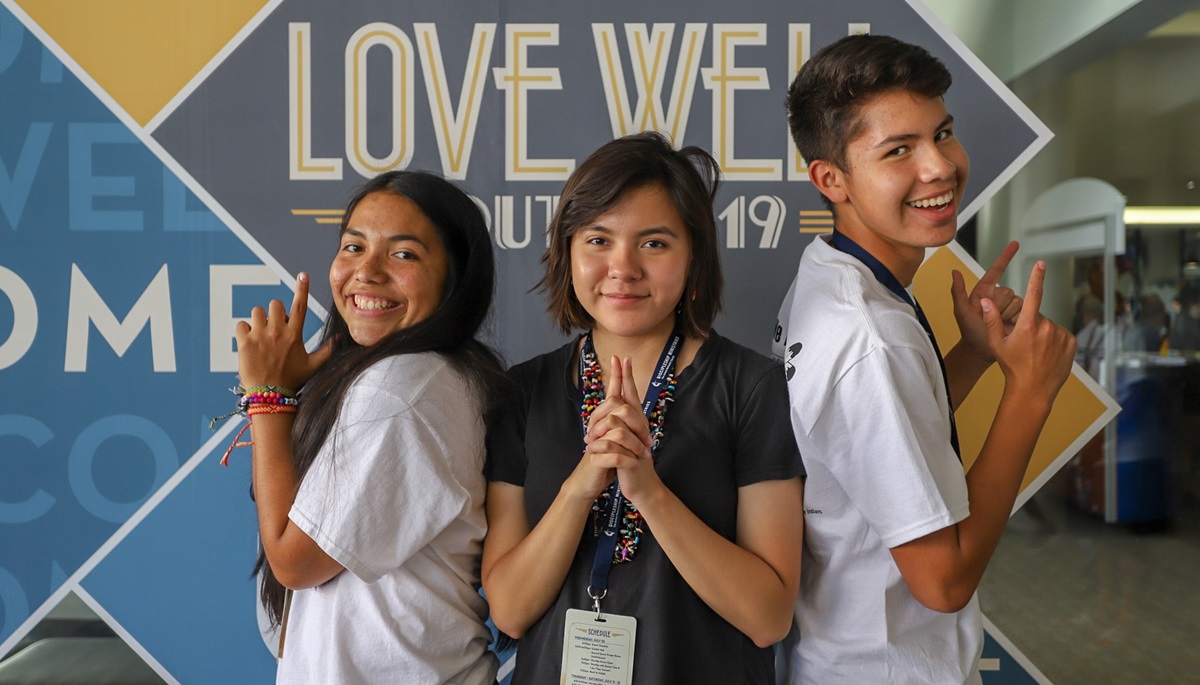A group of Native American young people from the Oklahoma Indian Missionary Conference raised their voices about Native-themed mascots and other issues important to their communities during the Youth 2019 national gathering.
The quadrennial national event, sponsored by United Methodist Discipleship Ministries, was held in Kansas City, Missouri. Since the city is home of the Kansas City Chiefs football team, leaders from the Oklahoma Indian Missionary Conference and other Native American communities worked with Youth 2019 planners to create a space to discuss the use of harmful Native mascots and other critical issues.
“We wanted to leverage the gathering in Kansas City to shine a light on pressing Native issues and to create awareness on how young United Methodists can be our ally and support our Native young people,” said the Rev. David Wilson, Oklahoma Indian Missionary Conference superintendent.
He said until 2012, the denomination’s Book of Resolutions included language that discouraged hosting events in cities with Native American mascots. A new resolution adopted in 2016 did not include the same text.
Three Native youth were selected for a panel on the mascot issue, preserving Native languages and the sacredness of water. The panel was offered four times throughout the July 10-13 event.
Alyssa Underwood, 16, a member of the Comanche Nation and a junior at Classen High School of Advanced Studies in Oklahoma City, shared a video she helped produce that explores how racist mascots and stereotypes affected her as a Native youth.
“You put me in a box to contain me, to absolve your guilt,” Underwood said on the “Know My Truth” video, which has more than 25,000 views through social media. “I am not a character; I am not a mascot. I am human. I have infinite value and worth.”
In addition to saying “no” to Native American-themed mascots or names in sports or commercial products, Underwood suggested young people do their homework and get to know Native people in their own communities.
“It is helpful to recognize that one Native American voice does not speak for all Native Americans,” said Underwood. “Approach conversations with several people for diverse opinions.”
She also recommended that young people engage with their conference’s Committee on Native American Ministries. The United Methodist Book of Discipline calls for every annual conference to have such a committee, she said.
Jariah Eyachabbe, 16, opened his discussion time with a Chickasaw greeting.
“Chokma, Jariah saholhchifoat,” which translates to, “Hello, my name is Jariah.”
He is of Choctaw, Chickasaw, Seminole, Muscogee-Creek and Euchee descent. Jariah is a junior at Norman High School in Norman, Oklahoma. For the past five years, Eyachabbe has been a part of the Rosetta Stone Chickasaw project. Forty immersive lessons have been developed to teach speakers conversational Chickasaw phrases used in daily life.
“A lot of our Native languages are dying,” said Eyachabbe in the video introduction. “There are less fluent speakers now than there ever was.”
He described historical events, such as the Trail of Tears, where tribes were scattered and people became separated, as contributing factors to languages being lost. The boarding school era for Native Americans also contributed to the decline because students were not allowed to speak their tribal languages.
“Our specific languages are given to us by the creator,” he said. “Speaking our language makes me feel more connected to my ancestors; I’m really grateful to be a part of it.”
Elonna LaFromboise, 18, a freshman at the University of Oklahoma, spoke about the sacredness of water. She was among the Native American water protectors who protested the Dakota Access Pipeline, which now runs through the Standing Rock Indian Reservation.
Growing up as a member of the Sisseton Wahpeton Oyate, Tonawanda Seneca, Absentee Shawnee and Sac & Fox tribes, she cultivated a deep respect for the use of water in sacred prayers and healing rituals.
“I am just a Native American with a responsibility to protect the land and stand up for my people … because water is life, water is all our lives, and water is my life,” LaFramboise said in the presentation video that originally posted on the TED-Ed Student Talks program.
She said now that the pipeline has been completed, the fears of tribal members have been realized because it already has leaked oil. The tribe continues legal opposition to the pipeline.
LaFromboise urged 2019 participants to be conscience of the sacredness of water and to take steps in their own community to protect the water and earth.
In addition to the panel, Underwood opened the entire Youth 2019 event acknowledging the original inhabitants in the Kansas City area, which included the Arapaho, Cheyenne, Comanche, Kansa, Kiowa, Osage, Pawnee and Wichita tribes. Eyachabbe led more than 3,000 participants in a prayer in the Chickasaw language.
The Native youth trip was funded through individual donations and a grant from the Native American Ministries Sunday fund.
Editor’s note: Alyssa Underwood is the daughter of writer Ginny Underwood.
Ginny Underwood is a communication consultant with ties to the Oklahoma Indian Missionary Conference. She is a member of the Comanche Nation of Oklahoma.
News media contact: Vicki Brown at 615-742-5470 or newsdesk@umcom.org. To read more United Methodist news, subscribe to the free Daily or Weekly Digests.
Like what you're reading? Support the ministry of UM News! Your support ensures the latest denominational news, dynamic stories and informative articles will continue to connect our global community. Make a tax-deductible donation at ResourceUMC.org/GiveUMCom.




